L’Art Nouveau est un style décoratif qui suit le design linéaire et les courbes des formes naturelles. L’Art Nouveau fleuri entre 1890 et 1910 en Europe et aux Etats Unis, et fut employé majoritairement dans l’architecture, le design intérieur, la bijouterie, le design du verre, les illustrations et les affiches.
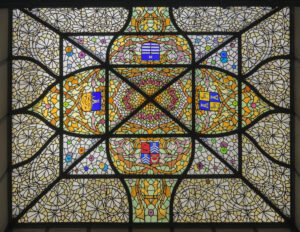
Barcelone est une des villes les plus remarquables en terme d’Art Nouveau. On y trouve l’incroyable travail d’Antoni Gaudí et d’autres architectes modernistes tels que Lluís Domènech i Montaner, Josep Puig i Cadafalch, Joan Rubió i Bellver et Jeroni Granell i Manresa, ainsi que de nombreux autres.
Histoire derrière l’émergence de l’Art Nouveau
During the 19th century, Barcelona had a growing number of wealthy upper class people. The industry was booming and there was a growing wealth in the city, putting the upper class in a financially strong position in this politically stable environment. This left the rest of Spain to fall into a serious economic and mental depression caused by the loss of the colonies Cuba, Puerto Rico & the Philippines.
Au 19ème siècle, Barcelone a vu un nombre croissant de personne de classe aisée s’installer. L‘industrie a explosé, ce qui a entrainé une croissance importante de la ville, en mettant la classe aisée dans une position de domination financière dans cet environnement politique stable. Le reste de l’Espagne tombe alors dans une grave dépression économique et mentale causée par la perte des colonies de Cuba, de Porto Rico et des Philippines.
De plus, dans cet environnement, il était presque inévitable que la classe huppée utilise leurs intérêts pour promouvoir la Renaissance. Durant ce romantique et revitalisant mouvement, la bourgeoisie a explicitement demandé aux artistes et architectes catalans de créer leur propre style et devenir populaire et riche grâce à ca. Il s’est vite avéré que ce concept bien connu de construction de grands et impressionnants bâtiments permettrait de dépasser les réputations de la noblesse.
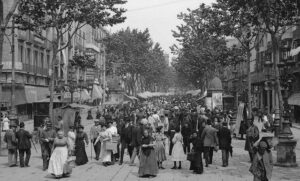
So where can we find the most impressive examples of art Nouveau throughout the city? This specific type of art has been flowering since 1859 when Ildefons Cerdà designed the beautiful Eixample area to make room for the growing population.
Ou pouvons nous trouver les exemples les plus impressionnants de l’Art Nouveau à travers la ville ? Ce type d’art spécifique a fleuri depuis 1859 lorsque Ildefons Cerda a élaboré le magnifique quartier de Eixample pour faire des chambres pour la population grandissante;
Le patron le plus connu était certainement l’industriel Eusebi Guell, qui a découvert l’artiste Antoni Gaudi. Güell a assigné de nombreux projets à son protégé comprenant la surprenante ville du Palau Guell ainsi que le Parc Guell.
Où trouver les meilleurs exemples d’Art Nouveau à Barcelone
1. Palais de la Musique Catalane
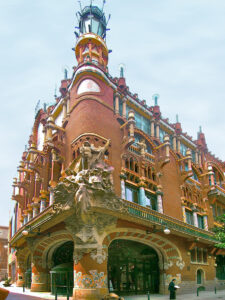
Ce bâtiment est une œuvre d’art incontournable. Le Palau de la Música Catalana est inscrit sur la liste du patrimoine mondial de l’UNESCO et se trouve dans le magnifique quartier gothique. La salle de concert du palais de la musique est immense et impressionnante, conçue par l’architecte Lluís Domènech i Montaner.
Montaner était l’un des principaux représentants de l‘art du Modernisme, étant l’un des architectes les plus renommés de Barcelone à cette époque. Cet incroyable bâtiment a été construit à partir de 1905 et financé par des dons de riches marchands et industriels.
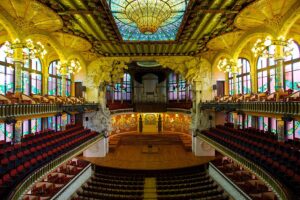
La façade est ornée de colonnes décorées de mosaïques et constitue un véritable must pour ceux qui aiment admirer l’art nouveau. Si vous souhaitez en savoir plus sur cette œuvre d’art, découvrez le Palau de Música Catalana.
Visitez le website of Palau de la Música Calatana pour réserver vos billets.
2. La Sagrada Familia
Au 19e siècle, le président de la Sainte Confrérie, José María Bocabella, projetait de construire à Barcelone une église dédiée à la sainte famille « sagrada familia ». Gaudí a influencé de manière significative la construction de la Sagrada Familia en guidant les architectes à l’aide de ses plans, modèles et documents.
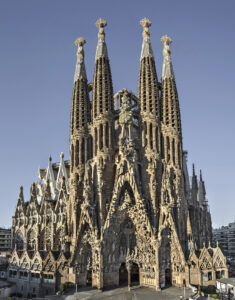
Aujourd’hui, la Sagrada Familia n’est pas seulement profondément religieuse mais aussi un symbole de l’art, ce qui se reflète dans chaque pierre du bâtiment ainsi que dans ses façades et ses tours. Les façades de ce magnifique édifice sont consacrées aux dogmes les plus importants du catholicisme, ainsi qu’à l’origine, l’enfance et la jeunesse de Jésus.
Visitez le site web de la Sagrada Familia pour réserver des billets.
3. Casa Battló
Another masterpiece of Gaudí is the Casa Battló, this impressive building demonstrates Gaudí’s style in every detail. The Casa Battló refers greatly to the legend of Saint George, as the patron saint and symbol of modernism.
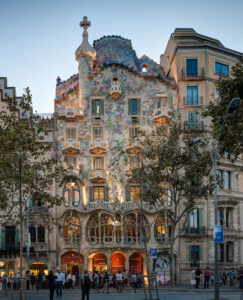
The roof of the Casa Batlló is shaped like a dragon with large, shiny scales, consisting of tiles on double attics, adapted to the organic architecture. This gorgeous building can be found down the Passeig de Grácia and is especially unmissable on the day of Sant Jordi where the building can be found covered in red roses.
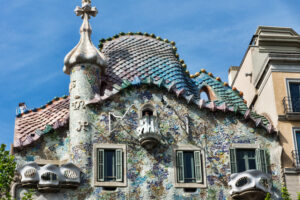
For more on Casa Batlló or the Celebration of Sant Jordi, read our blogs.
Visit the website for Casa Batllo here to book tickets
4. Casa Milá (La Pedrera)
The Casa Milá is an incredible Quarry House with no right angles. This was in fact the last building of Antoni Gaudí before he devoted himself to the Sagrada Familia. This is in the Eixample district and is one of the most impressive buildings of art modernisme nouveau. This building is also listed as a world heritage site by UNESCO.
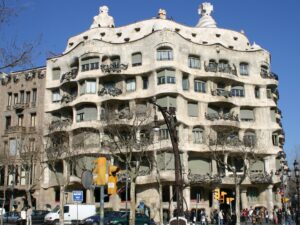
La Pedrera translates to “the quarry house”, getting its nickname of Casa Milá due to its unusual construction. The large stone slabs of the facade were first attached then worked on by the stonemasons. This building is rather colourless compared to the other work of Gaudí, making it unique and expressionistic.
This specific building is a perfect example of organic architecture, Gaudí used very little paint on this building to aim to keep the materials natural. The interior is just as impressive as the outside, with a natural ventilation system, making air conditioning unnecessary. To find out more information on the Casa Milà you can discover more in our blog.
Visit the website for La Pedrera here to book tickets
5. Palau Güell
As one of the most magnificent buildings of Modernisme, the Palau Güell is located in the Raval area, just metres from the Rambla. Parts of the facade of the Palau Güell are reminiscent of a Venetian palace, with two striking oval gates at the front.
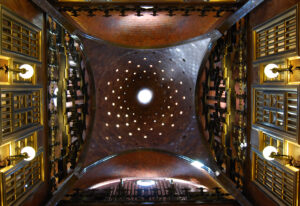
This is one of Antoni Gaudí’s earlier works, this was supposed to become a multipurpose building, with apartments, events and exhibition spaces. This was one of the first major projects Güell entrusted to Gaudí in the Barcelona Modernist style. To discover more about Güell’s relationship with Gaudí, check out our blog on Barcelona Modernism and the relationship between Gaudí and Güell.
Visit the Palau Guell website here to book tickets
6. Hospital de Santa Creu i de Sant Pau
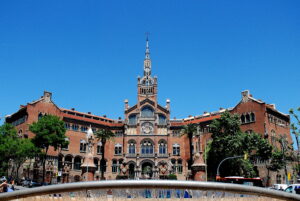
This amazing piece of art evolved from a mediaeval charitable home to a modern hospital since its founding 600 years prior. This is one of the most beautiful and significant modernistic complexes. This place is rather a complete work of art, with its colourised freshness, this is a beautiful complex from the time of Modernisme, and a masterpiece by Lluis Domènech i Montaner.
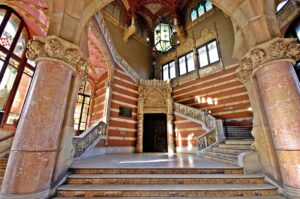
This is also on the list of UNESCO world heritage. This hospital has become something very special to the city of Barcelona, with it being surrounded by trees it has a somewhat very relaxed environment. It is a mediaeval and moorish influenced architecture, which is typical in Catalan art Nouveau. To learn more about the Hospital Sant Pau and its history, check out our blog on the world’s best modernist hospital.
Visit the website tiqets to book tickets to the Sant Pau Art Nouveau Site and skip the line.



Leave a Reply